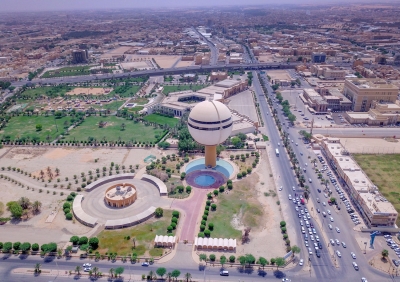



King Fahd Causeway is a sea bridge that links the Kingdom of Saudi Arabia and the Kingdom of Bahrain across the Arabian Gulf. The causeway is twenty-five km long, and extends from Aziziyah, south of al-Khobar in the Kingdom, to al-Jasra, west of Manama, the capital of Bahrain. It is connected to a network of internal roads in both countries.
King Fahd bin Abdulaziz Al Saud and Sheikh Isa bin Salman Al Khalifa officially opened the bridge in 1986. The National ID is sufficient for citizens of both countries to cross the causeway.
Specifications of King Fahd Causeway
King Fahd Causeway features two roadways, with a width of 23.2 m, 11.6 m per lane, and a curb for emergency parking.
The causeway rests on 536 concrete pylons. Its construction required 47,000 t of reinforced steel, 160,000 t of cement, 350 thousand m of concrete, and about 11 million m of sand and rock.
The concept of King Fahd Causeway
In 1954, King Saud bin Abdulaziz Al Saud expressed his desire to build a bridge that connects the two countries after a visit to Bahrain at the invitation of Sheikh Salman bin Hamad bin Isa Al Khalifa. In 1965, King Faisal bin Abdulaziz Al Saud ordered the formation of a special committee to study the implementation of the sea bridge. The construction agreement was signed in Manama in 1981 in the presence of Gulf Cooperation Council (GCC) leaders.
Start of construction
On November 11, 1982, the cornerstone was laid for King Fahd Causeway, marking the initiation of the project. The dimensions and coordinates of the causeway area were defined in 1985. Moreover, the King Fahd Causeway Authority was established to oversee security, safety, operational and commercial affairs, and engineering studies of the causeway.
In 1986, the causeway was officially launched by King Fahd bin Abdulaziz Al Saud and Sheikh Isa bin Salman Al Khalifa, the Emir of Bahrain at the time. It was named after King Fahd. The causeway's total cost of construction amounted to SAR3 billion and SAR13 million, including technical and administrative supervision, embankments, terminal, border buildings, and facilities.
Passport Island between Saudi Arabia and Bahrain
Passport island is situated on embankment No. 4, at the heart of the causeway, covering an estimated area of 660,000 m. It comprises two interconnected islands, the western side was designated for Saudi Arabia, and the eastern side for Bahrain.
King Fahd Causeway Authority will manage the western part of the island where its facilities, such as buildings, operating government departments, passport offices, customs, public security, and civil defense, are located. It also includes mosques, private bathrooms, restaurants, shops, green spaces, safe spaces for vehicles and trucks, and banks, which help visitors and travelers cross the bridge.
Services of King Fahd Causeway
In 2022, King Fahd Causeway Authority launched bank card and mobile payment services at the causeway's entrance gates. This helped reduce commuters' transit time to five seconds per vehicle. Moreover, the entrance and exit on the Bahraini side of the Passport Island were expanded to three tracks instead of two to shorten waiting periods.
The authority works in cooperation with the Bahrain Society of Engineers on a short-term expansion plan that began in 2018 and ends in 2024 to increase the capacity of fifty thousand vehicles per day, in addition to a medium-term plan that ends in 2030 to develop the transit areas of the causeway, increase the speed of passenger procedures, redesign the island, and expand its area in line with the rocketing number of travelers and their heavy movement. The number of travelers crossing the bridge reached 382 million passengers since its opening in 1986 until 2018. On March 4, 2023, the causeway registered the highest number in one day for the transit of passengers at about 136,498 since its opening thirty-six years ago. On the other hand, the former highest record was registered on January 11, 2020, with about 131,177 passengers.
Crossing procedures of King Fahd Causeway
Since the opening of the King Fahd Causeway, a national ID for the citizens of Bahrain and Saudi Arabia was sufficient to cross the bridge. However, during the COVID-19 pandemic in 2020, passengers were required to have a passport and a COVID-19 vaccine certificate.
Related quizzes
Related articles


